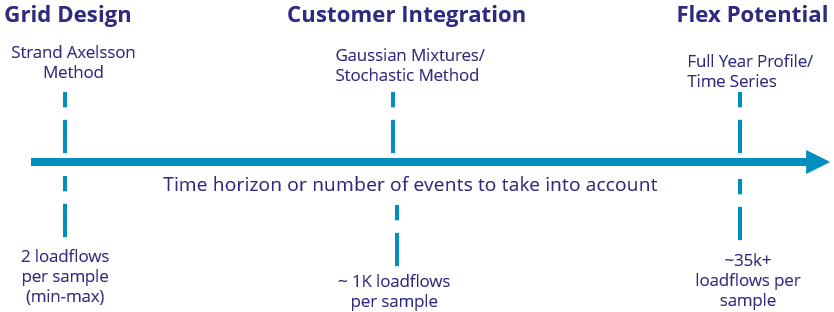Alliander’s Delvi Project Leverages LF Energy Power Grid Model to Direct Overhaul of Low Voltage Grid
Download this case study in PDF format
Delivering DSO Energy Transition with LF Energy Power Grid Model
Alliander’s Delvi Project Leverages Power Grid Model to Direct the Netherlands’ Largest Ever Overhaul Project of the Low Voltage Grid
Across the globe, Distribution System Operators (DSOs) are on the front line facing the unprecedented challenges around the energy transition. Alliander’s Delvi Project provides a visionary example of these efforts: utilizing cutting-edge modeling with LF Energy’s Power Grid Model tool to orchestrate vital upgrades to the Low Voltage (LV) Grid. Delvi is enabling Alliander to steer a path through the most significant grid transformation in the history of the energy industry.
Addressing Monumental Challenges for the LV Grid
Governments, industry, and broader society are only now waking up to the grid requirements necessary to enable the vision of decarbonization, electrification, and decentralized renewable and microgeneration. However for DSOs this transition is already well underway and accelerating at an ever-increasing rate.
Blanket upgrades across the Low Voltage (LV) Grid are both operationally and financially unachievable. For DSOs the only viable route forwards is to carefully orchestrate, time and target a program of ongoing upgrades, with a level of precision that preempts growth patterns, avoids outages, and ensures a smooth transition.
While LV Grid capacity requirements are growing universally, the uptake of renewables is not growing at an even rate across different geographical areas or across different segments of business and society. For Alliander, this presented a mission-critical operational imperative: to identify upcoming demand hotspots and to channel limited upgrade budgets effectively in order to meet demand ahead of where and when it arises.
- Changing Demand on the LV Grid: The combined effects of increased electrification (e.g. EVs, heat pumps and the electrification of business and industry) together with decentralized nature of renewable energy and microgeneration are not only increasing demand, but altering the required scope, function, and load dynamics of the LV Grid.
- No “Forklift” Upgrades: Feasibility limitations (i.e. available workforce and resource availability) and the need for service continuity, mean upgrades to grid capacity must be managed as part of an ongoing process working around growing and evolving demand.
- Uneven Adoption Rates: The adoption rates for renewable technologies are highly uneven, presenting both challenges and opportunities for managing the process of transition to a next-generation LV Grid.
- Accurate Prediction: To prevent grid congestion and ensure continuous service, accurate modeling is crucial to make informed, proactive decisions around the timing and targeting of ongoing infrastructure investments.
The Delvi Project: Transforming Decision-Making
The Delvi Project relies on the open source Power Grid Model from LF Energy to transcribe the outcome of thousands of potential demand patterns on Alliander’s real-world LV Grid infrastructure. Using stochastic analysis to weigh outcomes, Delvi is used to prioritize and orchestrate upgrades to the grid in a way that mitigates bottlenecks and ensures continuity of service.
To achieve this level of weighted scenario planning, the performance of Power Grid Model is critical. For Alliander, the ability to run all the model components within cloud infrastructure was essential. However, it was Power Grid Model’s ability to leverage native shared memory multi-threading and support for parallel computing that unleashed the true forecasting potential of Delvi.
The Impact of Delvi
The significance of Delvi lies in its ability to foresee demand hotspots and allocate limited upgrade budgets effectively. By weighting thousands of predictions with granularity across different consumer types and local demand patterns, Delvi empowers Alliander to proactively orchestrate capacity upgrades, ensuring a seamless transition in LV Grid capacity without disruption.
Delvi Architecture
- Forecasting Future Load Profiles: Delvi starts by forecasting how network demand could change: modeling future customer usage patterns by combining the latest academic research on renewable technology adoption, together with a segmented view of current demand based on existing smart meter measurements.
- Stochastic Analysis: Leveraging a stochastic approach, Delvi performs thousands of simulations to predict different scenarios of technology adoption and load variations across multiple time steps (e.g., every 15 minutes).
- Power Grid Model Simulations: Power Grid Model is then employed to perform load flow calculations and analyze the current distributionwithin the network. This step helps anticipate potential issues such as voltage complaints, capacity problems, or bottlenecks due to the growing adoption of new technologies.
- Scenario-Based Planning: The tool generates different scenarios (low, medium, high adoption) for various technologies. These scenarios help simulate the impact of different technology adoption rates on the grid, allowing for prioritization and orchestration of mitigation steps based on the forecasted scenarios.

